Michał Woźniak
$F_β$-plot -- a visual tool for evaluating imbalanced data classifiers
Apr 11, 2024Abstract:One of the significant problems associated with imbalanced data classification is the lack of reliable metrics. This runs primarily from the fact that for most real-life (as well as commonly used benchmark) problems, we do not have information from the user on the actual form of the loss function that should be minimized. Although it is pretty common to have metrics indicating the classification quality within each class, for the end user, the analysis of several such metrics is then required, which in practice causes difficulty in interpreting the usefulness of a given classifier. Hence, many aggregate metrics have been proposed or adopted for the imbalanced data classification problem, but there is still no consensus on which should be used. An additional disadvantage is their ambiguity and systematic bias toward one class. Moreover, their use in analyzing experimental results in recognition of those classification models that perform well for the chosen aggregated metrics is burdened with the drawbacks mentioned above. Hence, the paper proposes a simple approach to analyzing the popular parametric metric $F_\beta$. We point out that it is possible to indicate for a given pool of analyzed classifiers when a given model should be preferred depending on user requirements.
Continual Learning with Weight Interpolation
Apr 09, 2024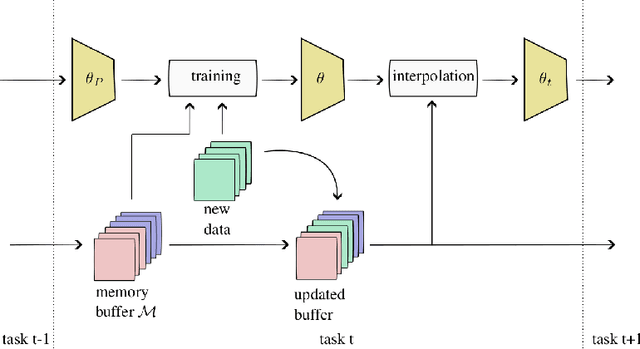
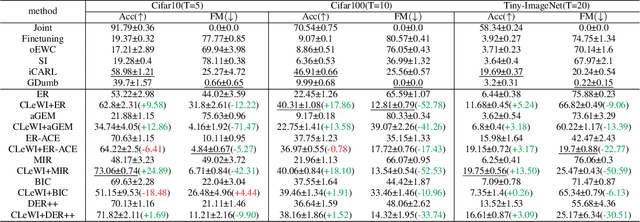
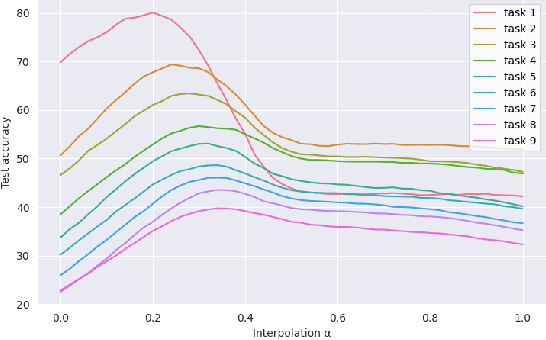

Abstract:Continual learning poses a fundamental challenge for modern machine learning systems, requiring models to adapt to new tasks while retaining knowledge from previous ones. Addressing this challenge necessitates the development of efficient algorithms capable of learning from data streams and accumulating knowledge over time. This paper proposes a novel approach to continual learning utilizing the weight consolidation method. Our method, a simple yet powerful technique, enhances robustness against catastrophic forgetting by interpolating between old and new model weights after each novel task, effectively merging two models to facilitate exploration of local minima emerging after arrival of new concepts. Moreover, we demonstrate that our approach can complement existing rehearsal-based replay approaches, improving their accuracy and further mitigating the forgetting phenomenon. Additionally, our method provides an intuitive mechanism for controlling the stability-plasticity trade-off. Experimental results showcase the significant performance enhancement to state-of-the-art experience replay algorithms the proposed weight consolidation approach offers. Our algorithm can be downloaded from https://github.com/jedrzejkozal/weight-interpolation-cl.
A Natural Gas Consumption Forecasting System for Continual Learning Scenarios based on Hoeffding Trees with Change Point Detection Mechanism
Sep 07, 2023



Abstract:Forecasting natural gas consumption, considering seasonality and trends, is crucial in planning its supply and consumption and optimizing the cost of obtaining it, mainly by industrial entities. However, in times of threats to its supply, it is also a critical element that guarantees the supply of this raw material to meet individual consumers' needs, ensuring society's energy security. This article introduces a novel multistep ahead forecasting of natural gas consumption with change point detection integration for model collection selection with continual learning capabilities using data stream processing. The performance of the forecasting models based on the proposed approach is evaluated in a complex real-world use case of natural gas consumption forecasting. We employed Hoeffding tree predictors as forecasting models and the Pruned Exact Linear Time (PELT) algorithm for the change point detection procedure. The change point detection integration enables selecting a different model collection for successive time frames. Thus, three model collection selection procedures (with and without an error feedback loop) are defined and evaluated for forecasting scenarios with various densities of detected change points. These models were compared with change point agnostic baseline approaches. Our experiments show that fewer change points result in a lower forecasting error regardless of the model collection selection procedure employed. Also, simpler model collection selection procedures omitting forecasting error feedback leads to more robust forecasting models suitable for continual learning tasks.
Transfer of knowledge among instruments in automatic music transcription
Apr 30, 2023Abstract:Automatic music transcription (AMT) is one of the most challenging tasks in the music information retrieval domain. It is the process of converting an audio recording of music into a symbolic representation containing information about the notes, chords, and rhythm. Current research in this domain focuses on developing new models based on transformer architecture or using methods to perform semi-supervised training, which gives outstanding results, but the computational cost of training such models is enormous. This work shows how to employ easily generated synthesized audio data produced by software synthesizers to train a universal model. It is a good base for further transfer learning to quickly adapt transcription model for other instruments. Achieved results prove that using synthesized data for training may be a good base for pretraining general-purpose models, where the task of transcription is not focused on one instrument.
Scalable handwritten text recognition system for lexicographic sources of under-resourced languages and alphabets
Mar 28, 2023Abstract:The paper discusses an approach to decipher large collections of handwritten index cards of historical dictionaries. Our study provides a working solution that reads the cards, and links their lemmas to a searchable list of dictionary entries, for a large historical dictionary entitled the Dictionary of the 17th- and 18th-century Polish, which comprizes 2.8 million index cards. We apply a tailored handwritten text recognition (HTR) solution that involves (1) an optimized detection model; (2) a recognition model to decipher the handwritten content, designed as a spatial transformer network (STN) followed by convolutional neural network (RCNN) with a connectionist temporal classification layer (CTC), trained using a synthetic set of 500,000 generated Polish words of different length; (3) a post-processing step using constrained Word Beam Search (WBC): the predictions were matched against a list of dictionary entries known in advance. Our model achieved the accuracy of 0.881 on the word level, which outperforms the base RCNN model. Within this study we produced a set of 20,000 manually annotated index cards that can be used for future benchmarks and transfer learning HTR applications.
Combining Self-labeling with Selective Sampling
Jan 11, 2023



Abstract:Since data is the fuel that drives machine learning models, and access to labeled data is generally expensive, semi-supervised methods are constantly popular. They enable the acquisition of large datasets without the need for too many expert labels. This work combines self-labeling techniques with active learning in a selective sampling scenario. We propose a new method that builds an ensemble classifier. Based on an evaluation of the inconsistency of the decisions of the individual base classifiers for a given observation, a decision is made on whether to request a new label or use the self-labeling. In preliminary studies, we show that naive application of self-labeling can harm performance by introducing bias towards selected classes and consequently lead to skewed class distribution. Hence, we also propose mechanisms to reduce this phenomenon. Experimental evaluation shows that the proposed method matches current selective sampling methods or achieves better results.
Increasing Depth of Neural Networks for Life-long Learning
Feb 22, 2022



Abstract:Increasing neural network depth is a well-known method for improving neural network performance. Modern deep architectures contain multiple mechanisms that allow hundreds or even thousands of layers to train. This work is trying to answer if extending neural network depth may be beneficial in a life-long learning setting. In particular, we propose a novel method based on adding new layers on top of existing ones to enable the forward transfer of knowledge and adapting previously learned representations for new tasks. We utilize a method of determining the most similar tasks for selecting the best location in our network to add new nodes with trainable parameters. This approach allows for creating a tree-like model, where each node is a set of neural network parameters dedicated to a specific task. The proposed method is inspired by Progressive Neural Network (PNN) concept, therefore it is rehearsal-free and benefits from dynamic change of network structure. However, it requires fewer parameters per task than PNN. Experiments on Permuted MNIST and SplitCIFAR show that the proposed algorithm is on par with other continual learning methods. We also perform ablation studies to clarify the contributions of each system part.
Active Weighted Aging Ensemble for Drifted Data Stream Classification
Dec 19, 2021
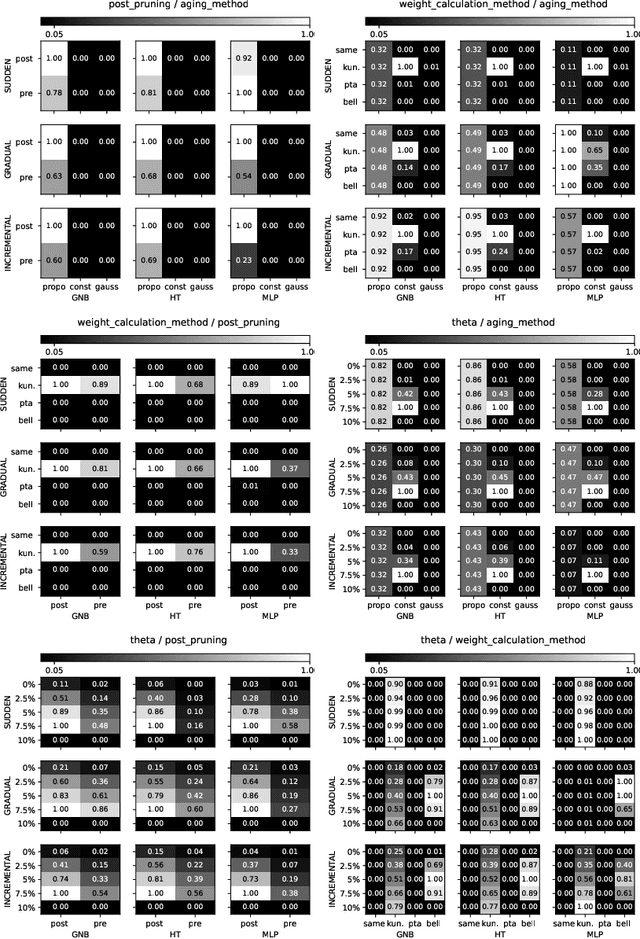
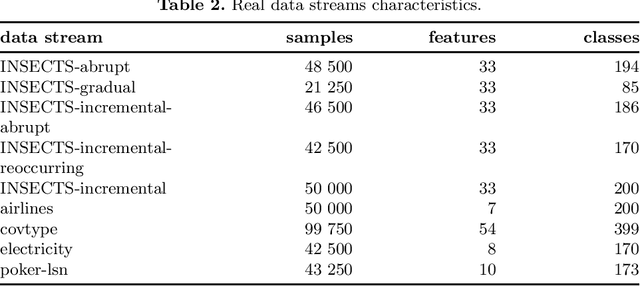
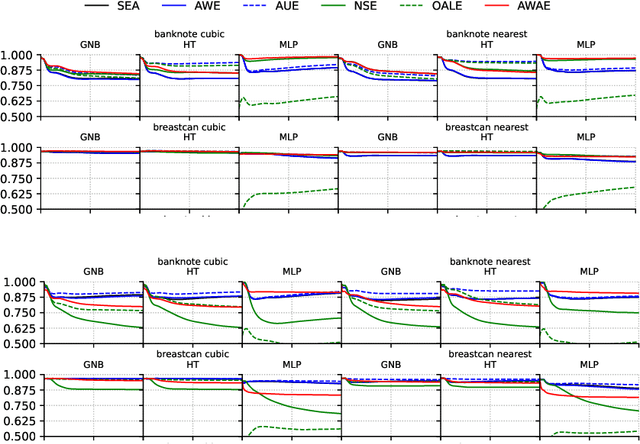
Abstract:One of the significant problems of streaming data classification is the occurrence of concept drift, consisting of the change of probabilistic characteristics of the classification task. This phenomenon destabilizes the performance of the classification model and seriously degrades its quality. An appropriate strategy counteracting this phenomenon is required to adapt the classifier to the changing probabilistic characteristics. One of the significant problems in implementing such a solution is the access to data labels. It is usually costly, so to minimize the expenses related to this process, learning strategies based on semi-supervised learning are proposed, e.g., employing active learning methods indicating which of the incoming objects are valuable to be labeled for improving the classifier's performance. This paper proposes a novel chunk-based method for non-stationary data streams based on classifier ensemble learning and an active learning strategy considering a limited budget that can be successfully applied to any data stream classification algorithm. The proposed method has been evaluated through computer experiments using both real and generated data streams. The results confirm the high quality of the proposed algorithm over state-of-the-art methods.
Employing chunk size adaptation to overcome concept drift
Oct 25, 2021



Abstract:Modern analytical systems must be ready to process streaming data and correctly respond to data distribution changes. The phenomenon of changes in data distributions is called concept drift, and it may harm the quality of the used models. Additionally, the possibility of concept drift appearance causes that the used algorithms must be ready for the continuous adaptation of the model to the changing data distributions. This work focuses on non-stationary data stream classification, where a classifier ensemble is used. To keep the ensemble model up to date, the new base classifiers are trained on the incoming data blocks and added to the ensemble while, at the same time, outdated models are removed from the ensemble. One of the problems with this type of model is the fast reaction to changes in data distributions. We propose a new Chunk Adaptive Restoration framework that can be adapted to any block-based data stream classification algorithm. The proposed algorithm adjusts the data chunk size in the case of concept drift detection to minimize the impact of the change on the predictive performance of the used model. The conducted experimental research, backed up with the statistical tests, has proven that Chunk Adaptive Restoration significantly reduces the model's restoration time.
RB-CCR: Radial-Based Combined Cleaning and Resampling algorithm for imbalanced data classification
May 09, 2021



Abstract:Real-world classification domains, such as medicine, health and safety, and finance, often exhibit imbalanced class priors and have asynchronous misclassification costs. In such cases, the classification model must achieve a high recall without significantly impacting precision. Resampling the training data is the standard approach to improving classification performance on imbalanced binary data. However, the state-of-the-art methods ignore the local joint distribution of the data or correct it as a post-processing step. This can causes sub-optimal shifts in the training distribution, particularly when the target data distribution is complex. In this paper, we propose Radial-Based Combined Cleaning and Resampling (RB-CCR). RB-CCR utilizes the concept of class potential to refine the energy-based resampling approach of CCR. In particular, RB-CCR exploits the class potential to accurately locate sub-regions of the data-space for synthetic oversampling. The category sub-region for oversampling can be specified as an input parameter to meet domain-specific needs or be automatically selected via cross-validation. Our $5\times2$ cross-validated results on 57 benchmark binary datasets with 9 classifiers show that RB-CCR achieves a better precision-recall trade-off than CCR and generally out-performs the state-of-the-art resampling methods in terms of AUC and G-mean.
 Add to Chrome
Add to Chrome Add to Firefox
Add to Firefox Add to Edge
Add to Edge